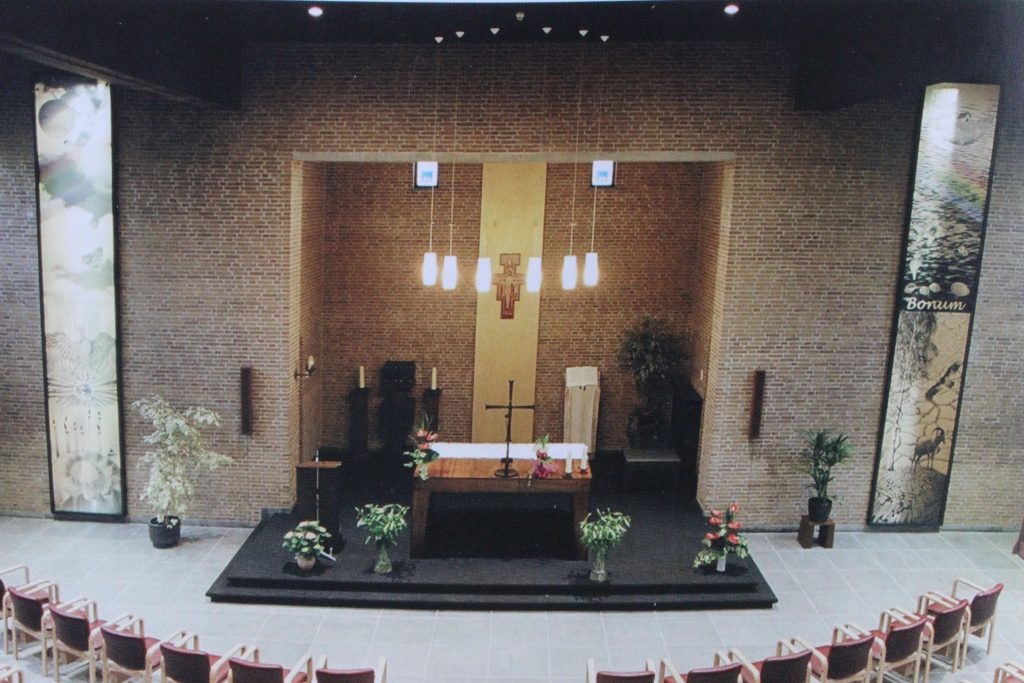In the south of the Netherlands, a 20th-century chapel connected to a Franciscan convent was built according to the principle of the “plastic number,” a theory developed by the Bossche School. Founded by Benedictine monk Hans van der Laan, the Bossche School searched for basic architectural principles derived from mathematical ratios in nature, which meant that building designs were calculated rather than drawn.
In the south of the Netherlands, a 20th-century chapel connected to a Franciscan convent was built according to the principle of the “plastic number,” a theory developed by the Bossche School. Founded by Benedictine monk Hans van der Laan, the Bossche School searched for basic architectural principles derived from mathematical ratios in nature, which meant that building designs were calculated rather than drawn.
Believing the chapel was in urgent need of renovation, the Mother Superior commissioned an architect to optimize the heating in the chapel and re-orient the seating. One challenge was the lack of natural lighting in the chapel. The architect’s solution was to create two oblong windows positioned symmetrically on either side of the alter and designed in harmony with the interior of the chapel, in keeping with Bossche principles.
The architect brought in visual artist Ellen Brouwers to decorate the two window panes, each measuring 6 x 1 meters. Because of the large size of the windows and the printing requirements of the design, screen printing was the most appropriate choice even though only two panes of glass were involved. The company contracted for the job specialized in screen printing glass and had presses large enough to accommodate such large panes of glass.
The printer used 7 x 2.4-meter screen frames for the job with a mesh that had 68 threads/centimeter (about 165 threads/inch) and a 55-micron thread diameter. (Even though the aluminum screen frames had a 10-centimeter profile, the tension over such a large frame still caused the long sides of the frame to bow approximately 10 centimeters.) Since the company used water-based enamel inks, a water-resistant emulsion was used. The screens were imaged digitally using a CTS system.
Advertisement
Each image required four colors:
• A translucent gold paint printed in a flood coat, responsible for the spectacular lighting effects of the final windows;
• A blue highlight for some of the motifs in the design;
• The main image, in black, printed from a 16 lines/centimeter halftone;
• And a rainbow effect printed in a single pass using the color-blend technique, with red, yellow, green, and blue inks placed carefully in front of the squeegee, producing a very realistic rainbow as the colors blended during the print stroke.
To remove the water from the inks, the printed glass was dried at 356°F using hot air and IR radiation before being cured at 1300°F. The renovated chapel was inaugurated four days after production was finished.
Read our full update on architectural glass decoration here.


 Case Studies2 months ago
Case Studies2 months ago
 Art, Ad, or Alchemy2 months ago
Art, Ad, or Alchemy2 months ago
 Andy MacDougall2 months ago
Andy MacDougall2 months ago
 Columns4 weeks ago
Columns4 weeks ago
 Editor's Note3 weeks ago
Editor's Note3 weeks ago
 Marshall Atkinson3 weeks ago
Marshall Atkinson3 weeks ago
 Thomas Trimingham2 months ago
Thomas Trimingham2 months ago
 Case Studies4 weeks ago
Case Studies4 weeks ago


















